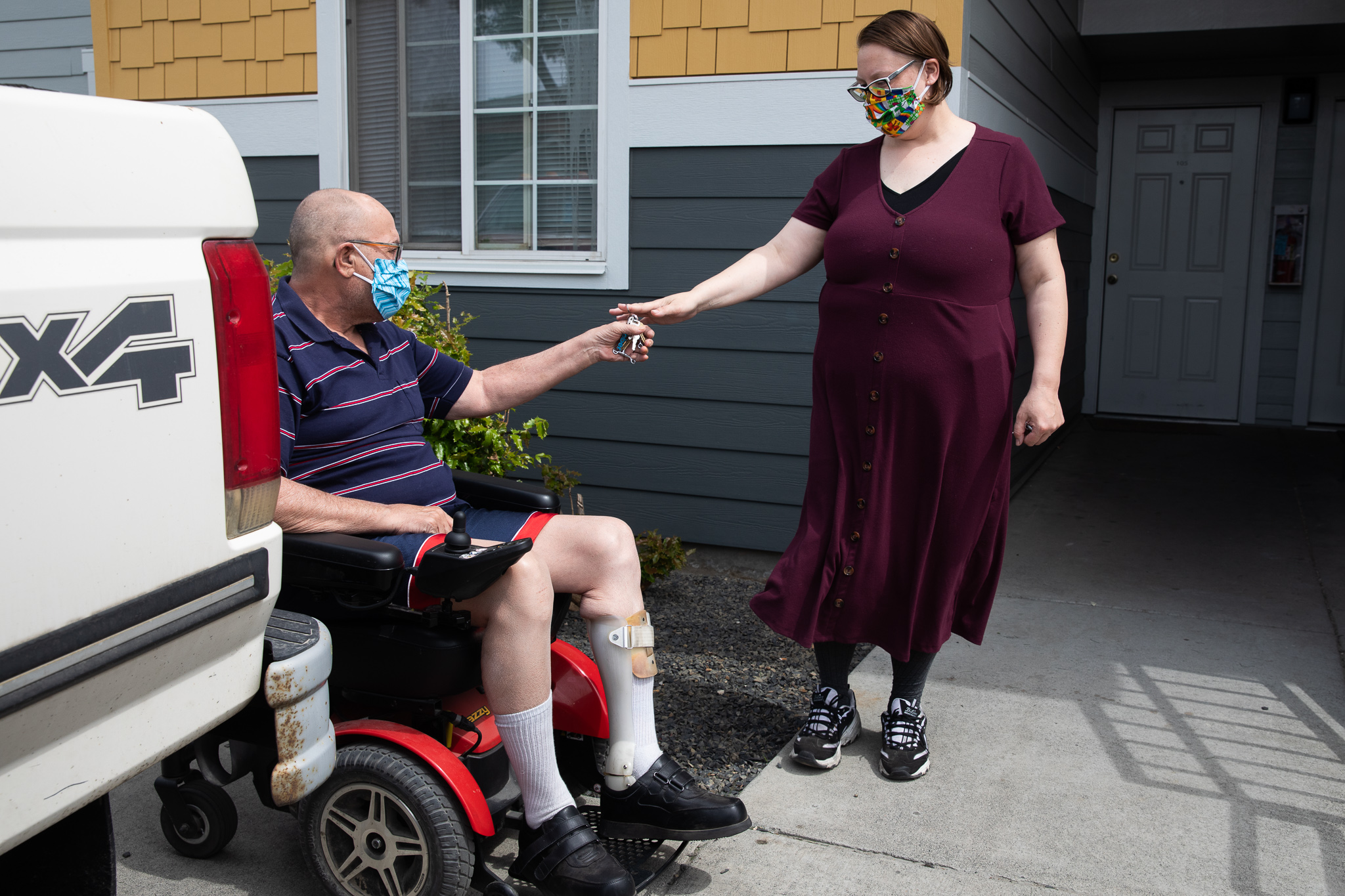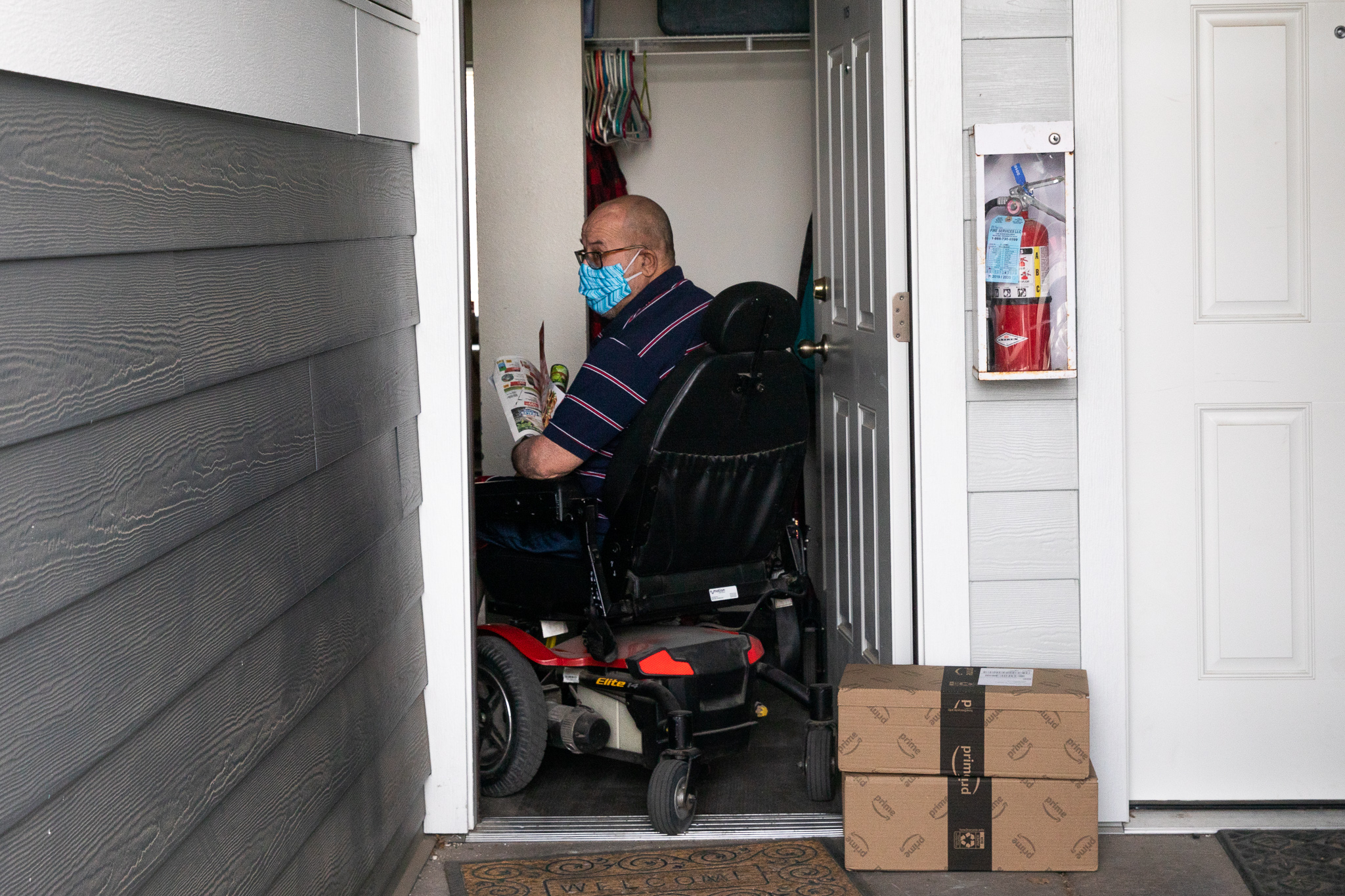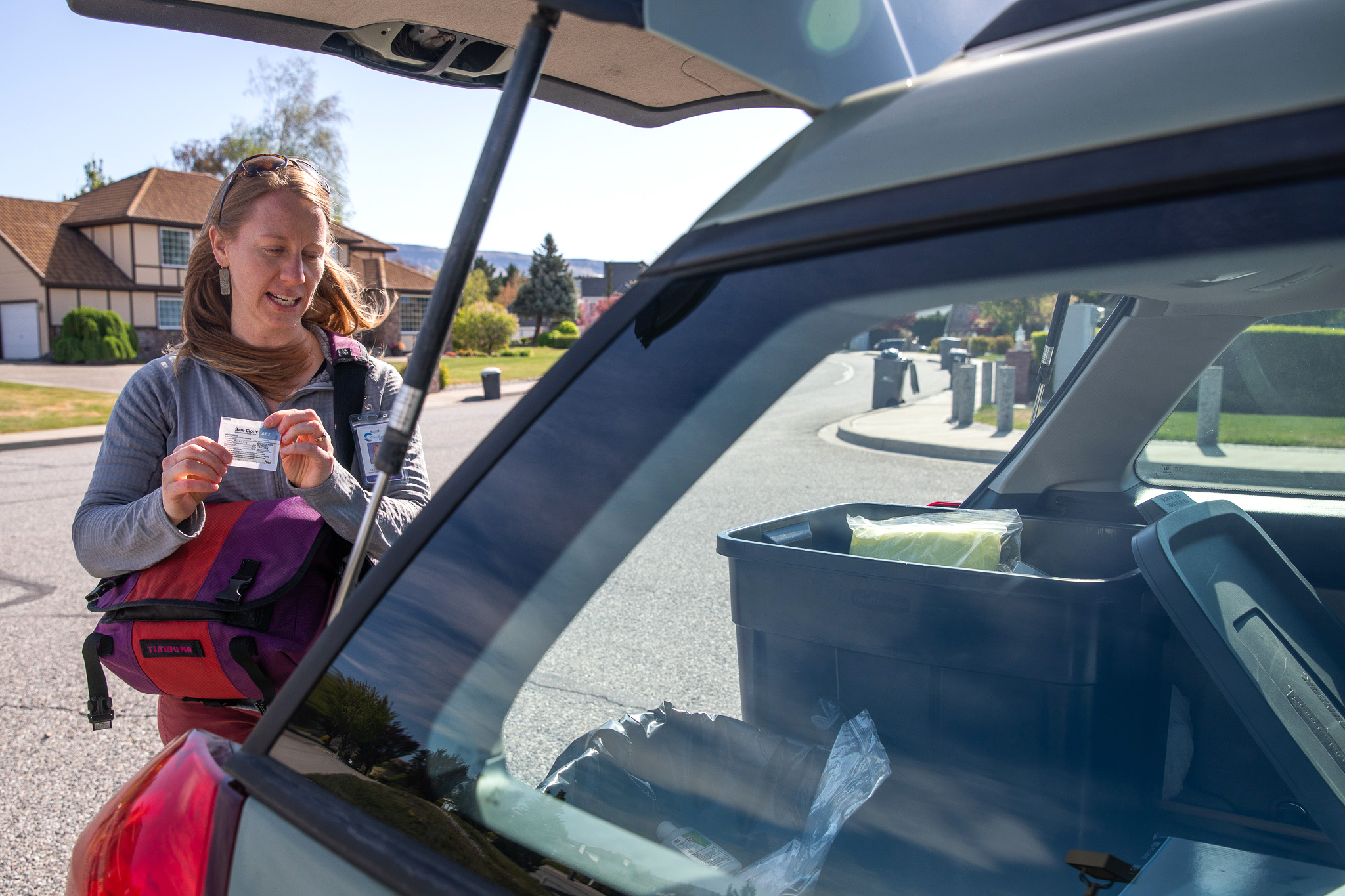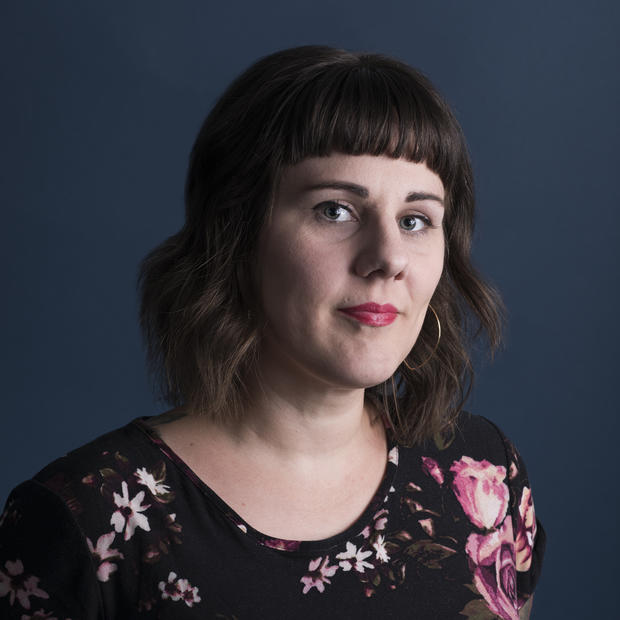While she gets gloves through her home care agency, they were able to secure only two disposable masks for each worker or agency provider. Although they’re single-use medical masks, Williams washes and reuses them.
Williams, who has been doing this work for six years, is also an individual provider, where the personal protective equipment (PPE) situation is more dire. Individual caregivers work for clients through DSHS — and not a clinic or agency — and must depend on their own ingenuity to secure gloves and masks. Williams ended up sewing her own mask, taking a bandana provided by her union and using other materials from Dollar Tree. Through trial and error, she ended up with one reusable mask to use every day for both her clients. That means there is only one mask for use not only in the clients’ homes, but also for taking transit, running their errands, taking her clients to appointments and protecting herself outside of work.
She made the mask herself, Williams said, because on a caregiver’s salary, she can’t afford to buy them.
This is a problem mirrored in communities across the county. A Home Care Association of America survey conducted in March found that over three-quarters of respondents didn't have enough masks or hand sanitizer, and more than half didn't have enough gloves. Of the country’s 3.3 million in-home caregivers, that could translate into a scarier, and less trackable, situation than today’s tightly controlled nursing home experience.
Wondering about other healthcare providers? Here's how respiratory therapists are coping.
Sterling Harders has been hearing the same from her union members. As president of SEIU 775, a union for 43,000 caregivers in Washington and a few thousand in Montana, she hears a lot of anxiety from caregivers. They provide care that can’t be done from 6 feet away, she said. Social distancing isn’t possible when you’re helping someone shower, eat or walk.
“Caregivers largely do not have the equipment that they need to do this work safely,” Harders said. “They’re angry that the federal government really fell down on the job and didn’t respond to this crisis sooner.”
They did just win a “huge victory” for the union, she said, in that Washington state in May is set to mail out three reusable masks to each caregiver who is an individual provider. About three-quarters of the union are individual providers. Harders called the state’s action a very late step.
“I have to say that this is part of the long trend with home care workers where they are not recognized as the health care professionals that they are,”she said.
She said it was challenging for home care workers to be in this position again — advocating for themselves — by calling lawmakers and signing petitions to beg for the equipment they needed to do their jobs safely.
In-home caregivers are essential in keeping people safely in their homes, Harders said. If they do their jobs right, more people will be kept out of nursing homes and hospitals.
“This pandemic has really shone a light on the critical importance of the work that home care workers do, because their folks are the high-risk folks, and if caregivers can keep their clients safe at home, then that helps keep all of us safer,” Harders said. Caregivers aren’t recognized as being on the front lines, she added, but “you don't get any more front line than being in somebody's bedroom.”
Williams agreed, adding that the public probably is not aware of the workers’ value, she cited the way people have stepped up to help hospital staff but not in-home caregivers.
“I don’t want people to take me wrong,” she said. “I love what people are doing, I think it’s amazing. You have so many companies that are stepping up making PPE for the hospitals … [but] no one, outside of the home care community, is doing it for us.”

Williams said she worries not just about her clients’ safety, but also about the possibility of infecting herself or her son, as well.
So when she gets home with her son, they stop at the door and take off their shoes, gloves and masks, which they wore on the bus. She hands her son a bottle of hand sanitizer. They wash their hands in the kitchen, take off their clothes and shower. Since their laundromat is a half-hour away, she puts all their “dirty” clothes in a room that’s shut off from the rest of the house. She even sanitizes the soles of their shoes.
And while she screens both of her clients at the beginning of every visit, she said that isn’t much comfort to her. The workers don’t take clients’ temperatures, and there’s no way to verify who else has been in the home. It’s completely up to clients to self-disclose — and that doesn’t feel good, she said, in part because if they pass along COVID-19 to her, she has to take time off from work.
For a single mother who works about 25 hours a week and makes $16.35 an hour in an expensive city like Seattle, there isn’t a lot left over. Williams said that while the union does provide paid time off, she prefers to save it for emergencies. Her daughter lives in another state, and she wants to make sure she can visit her if needed.
But recently, she and her son did become very sick. She was hospitalized, and while both of them tested negative for COVID-19, that meant she was out of work and her son out of child care. Williams wants hazard pay for the high-risk work that she does, she said, which not only pads the small paychecks, but signifies a shift in perception of caregivers.
“A virus shouldn’t have to come for people to realize that our job is important. Not just doctors save lives, not just nurses save lives, or police officers, or first responders,” Williams said. “They save it, then we maintain it.”
Another caregiver fighting for recognition is Desirae Hernandez, a 39-year-old mother living in Kennewick. She works 40 hours a week as an agency provider with Addus Home Care and 32 more as an individual provider for her father and her neighbor. She started caregiving in 2011, helping her father. He needed more and more assistance with basic tasks as he developed tremors in his hands; he also has congestive heart failure, diabetes and high blood pressure.
Her day begins early and ends late: She gets up with her dad about 4 a.m., shuttles over to her second client around 6 a.m., then returns to both in the evening. In addition to that seven-day-a-week schedule, from Tuesday to Saturday she also works from 8 a.m. to 4:30 p.m. with her agency client, Scott Philbeck.

She is deeply concerned about bringing the coronavirus into clients’ homes.
“I worry about being more of a problem for my clients than I am a solution. I don’t want to be the one to get them sick, and I also don’t want to get my family sick,” Hernandez said.
She lives in a full house: a son, two nephews, two nieces, her mother-in-law, her husband and her husband’s friend. A nephew is immunocompromised, and her mother-in-law and husband are high-risk.
The morning of her interview with Crosscut, Hernandez received a terrifying call: Her brother and sister-in-law both had tested positive for COVID-19. Neither lives in the home, but it made her heart race, living in a home with nine people and working with three at-risk clients, each of whom has contact with other people. The possibilities of contamination spread out like a spiderweb.
So she does what she can. She follows steps similar to Williams, but because she has a laundry machine in her home, she has the luxury of washing clothes and masks more often.
Hernandez has shoes and clothes she changes into when she arrives at every home. She showers at her father’s house, as well as at her own. She said the extra time and extra money to take all of these precautionary measures are piling up: With a household of nine and working over 70 hours a week, time is a precious commodity.
While Hernandez said she gets gloves through the union, she was provided only one disposable mask from her home care agency; it’s meant to last two weeks. So she purchased about 80 homemade masks from Facebook to hand out to other caregivers. That cost her about $120.
“It’s not much security but sometimes not much will get you through,” Hernandez said. “That was important to me that [caregivers] are cared for.”
Hernandez said most of the caregivers she handed them to weren’t financially able to reimburse her. A few gave her five bucks, but she wasn’t expecting anything in return, Hernandez said. She turned right around and bought more masks with those few extra dollars.
“They don’t have the extra money to start with, let alone right now,” Hernandez said. “My husband’s currently laid off, but it’s just one of those things that you just figure out,… At least I’m able to keep working, so I just did what I thought I needed to do.”
They shouldn’t have to fight for PPE, she said, and it should be the status quo, in times of a pandemic or not. She wants legislators to pay more attention to in-home caregivers and recognize the work they do as essential workers.
“We need to learn from this and prepare ourselves in the future,” Hernandez said. “We've worked without it because there's not a choice, but we can't do that anymore.”

Many readers have asked about ways to help during the pandemic. The tool below connects potential volunteers with organizations that need helpers. Learn more here or check out Be a Neighbor below.


